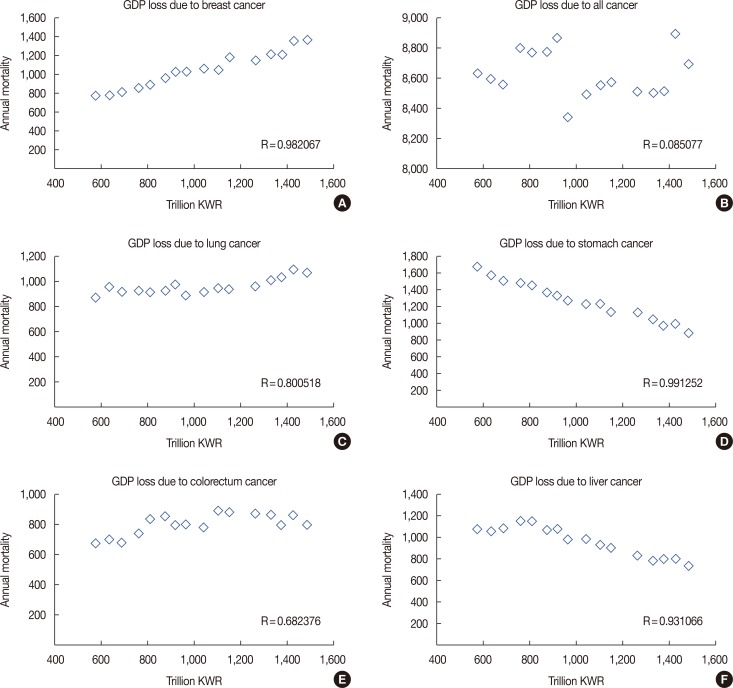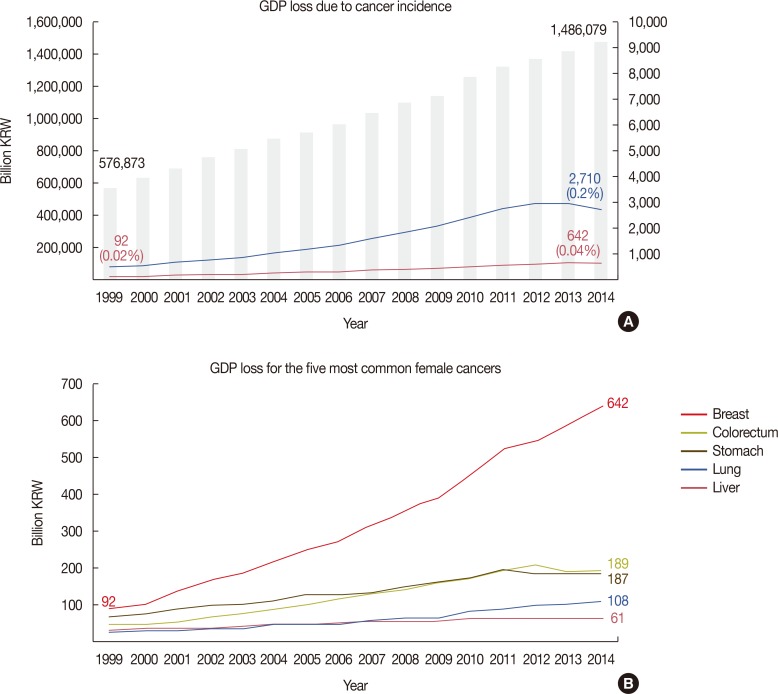J Breast Cancer.
2018 Mar;21(1):91-95. 10.4048/jbc.2018.21.1.91.
Breast Cancer Epidemiology of the Working-Age Female Population Reveals Significant Implications for the South Korean Economy
- Affiliations
-
- 1Strategic Planning Team, Office of Management & Support, Samsung Medical Center, Seoul, Korea.
- 2Division of Breast Surgery, Department of Surgery, Sungkyunkwan University School of Medicine, Seoul, Korea.
- 3Division of Hematology-Oncology, Department of Medicine, Sungkyunkwan University School of Medicine, Seoul, Korea. yhparkhmo@skku.edu
- 4Department of Radiation Oncology, Samsung Medical Center, Sungkyunkwan University School of Medicine, Seoul, Korea.
- KMID: 2441873
- DOI: http://doi.org/10.4048/jbc.2018.21.1.91
Abstract
- In this study, we aimed to evaluate the economic loss due to the diagnosis of breast cancer within the female South Korean working-age population. A population-based cost analysis was performed for cancer-related diagnoses between 1999 and 2014, using respective public government funded databases. Among the five most common cancers, breast cancer mortality was strongly associated with the growth in gross domestic product between 1999 and 2014 (R=0.98). In the female population, breast cancer represented the greatest productivity loss among all cancers, which was a consequence of the peak in the incidence of breast cancer during mid-working age in the working-age population, in addition to being the most common and fastest growing cancer among South Korean women. Our study shows that breast cancer not only represents a significant disease burden for individual patients, but also contributes a real, nonnegligible loss in productivity in the South Korean economy.
MeSH Terms
Figure
Reference
-
1. Economic and actuarial statistics. Korean Statistical Information Service. Accessed March 15th, 2017. http://kosis.kr/.2. Leong SP, Shen ZZ, Liu TJ, Agarwal G, Tajima T, Paik NS, et al. Is breast cancer the same disease in Asian and Western countries? World J Surg. 2010; 34:2308–2324. PMID: 20607258.
Article3. Son BH, Kwak BS, Kim JK, Kim HJ, Hong SJ, Lee JS, et al. Changing patterns in the clinical characteristics of Korean patients with breast cancer during the last 15 years. Arch Surg. 2006; 141:155–160. PMID: 16490892.
Article4. Park EH, Min SY, Kim Z, Yoon CS, Jung KW, Nam SJ, et al. Basic facts of breast cancer in Korea in 2014: the 10-year overall survival progress. J Breast Cancer. 2017; 20:1–11. PMID: 28382089.
Article5. Han W, Kang SY. Korean Breast Cancer Society. Relationship between age at diagnosis and outcome of premenopausal breast cancer: age less than 35 years is a reasonable cut-off for defining young age-onset breast cancer. Breast Cancer Res Treat. 2010; 119:193–200. PMID: 19350387.6. Park YH, Lee SJ, Jung HA, Kim SM, Kim MJ, Kil WH, et al. Prevalence and clinical outcomes of young breast cancer (YBC) patients according to intrinsic breast cancer subtypes: single institutional experience in Korea. Breast. 2015; 24:213–217. PMID: 25728283.
Article7. Ahn SH, Son BH, Kim SW, Kim SI, Jeong J, Ko SS, et al. Poor outcome of hormone receptor-positive breast cancer at very young age is due to tamoxifen resistance: nationwide survival data in Korea: a report from the Korean Breast Cancer Society. J Clin Oncol. 2007; 25:2360–2368. PMID: 17515570.8. Yoo KY, Kim Y, Park SK, Kang D. Lifestyle, genetic susceptibility and future trends of breast cancer in Korea. Asian Pac J Cancer Prev. 2006; 7:679–682. PMID: 17250452.9. Han W, Kim SW, Park IA, Kang D, Kim SW, Youn YK, et al. Young age: an independent risk factor for disease-free survival in women with operable breast cancer. BMC Cancer. 2004; 4:82. PMID: 15546499.
Article10. Shin HR, Boniol M, Joubert C, Hery C, Haukka J, Autier P, et al. Secular trends in breast cancer mortality in five East Asian populations: Hong Kong, Japan, Korea, Singapore and Taiwan. Cancer Sci. 2010; 101:1241–1246. PMID: 20219071.
Article11. Ferlay J, Soerjomataram I, Dikshit R, Eser S, Mathers C, Rebelo M, et al. Cancer incidence and mortality worldwide: sources, methods and major patterns in GLOBOCAN 2012. Int J Cancer. 2015; 136:E359–E386. PMID: 25220842.
Article12. Jung KW, Won YJ, Oh CM, Kong HJ, Lee DH, Lee KH. Cancer statistics in Korea: incidence, mortality, survival, and prevalence in 2014. Cancer Res Treat. 2017; 49:292–305. PMID: 28279062.
Article13. Cancer statistics. National Cancer Information Center. Accessed March 15th, 2017. http://ncc.re.kr/cancerStatsView.ncc.14. Suh I. Cardiovascular mortality in Korea: a country experiencing epidemiologic transition. Acta Cardiol. 2001; 56:75–81. PMID: 11357928.15. Luengo-Fernandez R, Leal J, Gray A, Sullivan R. Economic burden of cancer across the European Union: a population-based cost analysis. Lancet Oncol. 2013; 14:1165–1174. PMID: 24131614.
Article
- Full Text Links
- Actions
-
Cited
- CITED
-
- Close
- Share
- Similar articles
-
- Clinical characteristics of Korean breast cancer patients in 1998. The Korean Breast Cancer Society
- Potential of the Microbiome as a Biomarker for Early Diagnosis and Prognosis of Breast Cancer
- Participatory Training Activities in South Asia for Promoting Safety and Health in Informal Economy Workplaces—Roles of Trade Unions and Employer Organizations
- Incidence estimation of female breast cancer among Koreans
- Molecular Epidemiology of Breast Cancer



